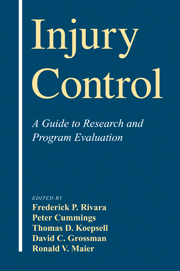Book contents
- Frontmatter
- Contents
- List of Contributors
- 1 An Overview of Injury Research
- 2 Classifying and Counting Injury
- 3 Measurement of Injury Severity and Co-morbidity
- 4 Data Linkages and Using Administrative and Secondary Databases
- 5 Rates, Rate Denominators, and Rate Comparisons
- 6 Data Collection Methods
- 7 Selecting a Study Design for Injury Research
- 8 Qualitative Methods in Injury Research
- 9 Randomized Trials
- 10 Cohort Studies in Injury Research
- 11 Case–Control Studies in Injury Research
- 12 Ecologic Studies
- 13 Case Series and Trauma Registries
- 14 Systematic Reviews of Injury Studies
- 15 Evaluating an Injury Intervention or Program
- 16 The Development of Clinical Decision Rules for Injury Care
- 17 Trauma Performance Improvement
- 18 Measuring Disability and Quality of Life Postinjury
- 19 Economic Evaluation of Injury Control
- 20 Ethical Issues
- Index
4 - Data Linkages and Using Administrative and Secondary Databases
Published online by Cambridge University Press: 16 October 2009
- Frontmatter
- Contents
- List of Contributors
- 1 An Overview of Injury Research
- 2 Classifying and Counting Injury
- 3 Measurement of Injury Severity and Co-morbidity
- 4 Data Linkages and Using Administrative and Secondary Databases
- 5 Rates, Rate Denominators, and Rate Comparisons
- 6 Data Collection Methods
- 7 Selecting a Study Design for Injury Research
- 8 Qualitative Methods in Injury Research
- 9 Randomized Trials
- 10 Cohort Studies in Injury Research
- 11 Case–Control Studies in Injury Research
- 12 Ecologic Studies
- 13 Case Series and Trauma Registries
- 14 Systematic Reviews of Injury Studies
- 15 Evaluating an Injury Intervention or Program
- 16 The Development of Clinical Decision Rules for Injury Care
- 17 Trauma Performance Improvement
- 18 Measuring Disability and Quality of Life Postinjury
- 19 Economic Evaluation of Injury Control
- 20 Ethical Issues
- Index
Summary
Introduction
Administrative and other databases originally created for purposes other than research are increasingly being considered for use in injury research. This is not surprising – those conducting health research or surveillance have always considered the potential uses and benefits of secondary data. This chapter attempts to provide an overview of the benefits and limitations of use of these electronic databases, categories of uses, types of databases that have been employed in injury research, and some of the methods used. It is by no means an exhaustive description of all such uses, nor is it intended as a text for conducting data linkages. Based on our experience, we have attempted to provide a framework for considering use of these databases or conducting linkages, and to raise awareness of some of the important issues that need to be considered.
For some research projects, there are several benefits associated with using administrative or secondary data. For purposes of this chapter, administrative data include data (not necessarily related to health status) routinely collected as part of the administrative operations of some organization. Examples of administrative data are drivers’ license records, employment rosters, vital records such as birth or death certificates, and insurance claims. “Secondary” databases typically encompass the administrative databases mentioned above as well as research or surveillance data that have been collected for purposes other than your own project. Issues to be discussed here that are related to data access, linkage, and use apply to both administrative and non-administrative, secondary databases and thus, the latter, more general term will be used to refer to both.
Keywords
- Type
- Chapter
- Information
- Injury ControlA Guide to Research and Program Evaluation, pp. 47 - 63Publisher: Cambridge University PressPrint publication year: 2000



